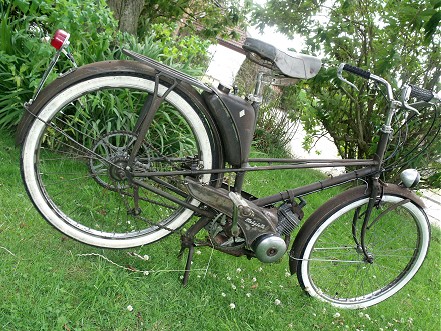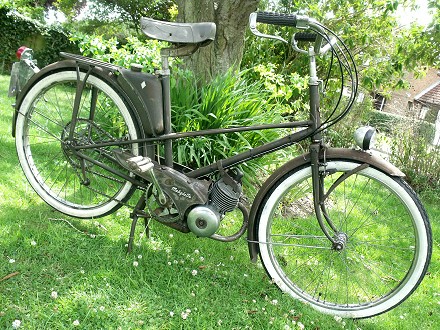
The French Motobécane and Motoconfort brands will probably be more familiarly known to many people in the form of various Mobylette moped models, but the company had become established in the production of motor cycles since the early 1920s and, after World War II, began manufacture of a super lightweight ‘Poney’ vélomoteur of 63cc. It soon became apparent that a popular new ‘economy’ transport was developing around 50cc pedal-assisted motors, so Motobécane set about the construction of a prototype in 1949 based on the assembly of existing components from other machines built onto a pre-war bicycle frame, which was strengthened for the purpose. Utilising a sleeved-down version of the Poney motor to 50cc, the new machine was little more than a basic and simple motorised bicycle. This ran direct drive by a primary belt to a fixed flywheel, which was tensioned by adjusting the engine, then the final drive chain tightened by movement of the rear wheel.
Named ‘Mobylette’, the new AV3 moped was presented to an enthusiastic public at the Utrecht Industries Fair in late 1949, and became an immediate hit. The appeal was its affordable simplicity, and it was a product that many cyclists of the day could readily relate to as a more effective transport for their daily commute to work, while its step-through tubular frame design appealed to both men and women.
The original AV3 Mobylette was officially only produced from 1949 until October 1952 and featured a rigid front fork and frame with calliper brakes front & rear and direct drive (no clutch).
People are often misled into mistaken identities by the model indicator plates riveted to the cylinder head bracket, which show ‘AV3’ anodised on the serial disc, but can fail to notice the extra number stamped in the alloy square next to it—it may really be, for example, an AV31 ‘Luxe’, which was the first variation from the AV3 with telescopic forks, front and rear drum brakes, and ‘automatic’ clutch that appeared in April 1952, and was built until 1955.
Even if the extra number in the stamped square might not be spotted, then the distinctive features of a Luxe make it easy to recognise, but what if the game gets harder?
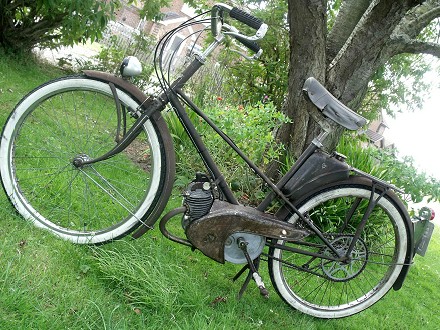
What about a machine like the one we have today?
It’s an AU-prefix Motoconfort-branded French home market machine, which is really only an alternative Motobécane brand badge of little other relevance.
Our example has the AV3 direct-drive engine, mounted in a rigid tubular frame, with rigid fork, calliper front and rear brakes, and to all intents & purposes would seem to meet the primary criteria of the AV3; however you do need to look a little more carefully.
It’s very common to fall into the trap of assuming that any machine fitted with an AV3 engine automatically makes the bike an AV3, but it doesn’t quite work like that.
This bike has a centre-stand, which is a feature that didn’t appear until 1954, while the original AV3 had already vanished from the manufacturer’s catalogue in October 1952.
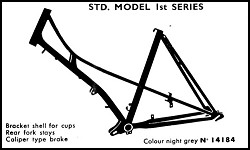

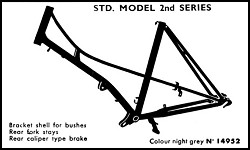


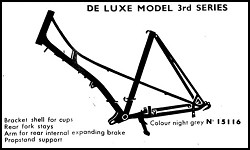
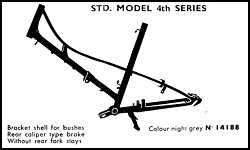
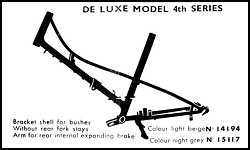
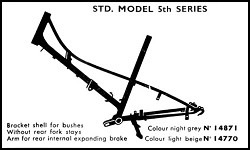
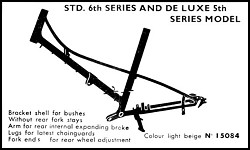
When playing the model dating game, the other Moby feature you need to be picking up on the radar is the frame style, which in this case has a straight top-tube, running all the way from the lower junction of the headstock tube to the rear axle. The bottom tube is also straight, running from the bottom of the headstock tube, to a junction point just above the pedal bracket. This is a very distinctive, and what Motobécane called a Standard Model third series frame, and quite unique in its simple and economic construction. Employing all-straight frame tubes saves money in material and forming operations where all other Standard and De Luxe first to third series frames employed bent tubes, and had all also employed rear stay tubes to the top of the saddle stem, where this frame does without these completely!
The model is a Motoconfort branded AU32 ‘Utilitaire’, which effectively replaced the original AV3 in October 1952, and entered the new catalogue along with the AV33 Super-Standard model, which had the usual curved frame tubes and drum rear brake.
The old-pattern small 2½ litre (0.55 gallon) fuel tank mounts in the crook of the frame between the saddle stem and rear mudguard, and its fuel supply is turned on by unscrewing a knob behind the saddle at the top of the tank. This works by a control rod through the inside of the tank, to a valve at the bottom in the outlet spigot—in case you thought that was some sort of magic.
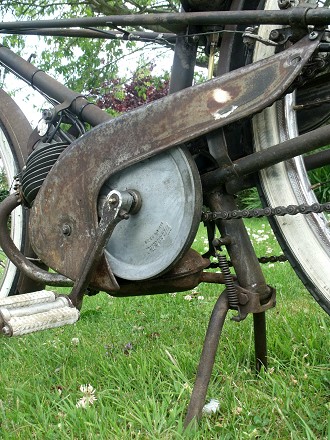
This first-series AV3 engine has no crank seals, so that means it needs to be run with a heavy mineral oil mix in the fuel. Recommended mix is 8% Castrol Z (SAE10), which is 12:1 ratio, and if you think that’s a bit thick … Motobécane further recommended an extra glutinous 9:1 ratio for running in a new engine! This high oil mix comes with the expected penalties of smoke, general oiliness around the lower parts of the machine, a rapid build up of carbon in the exhaust, and a dirty maintenance programme.
The choke operates by tweaking a small thumb trigger under the left bar grip, and turn the throttle twistgrip forward to decompress. Because the motor is direct-drive, it’s generally better to mount up and pedal along the road to get the motor spinning, then throttle back and keep pedalling to get the motor to fire.
If you do chose to start the bike on the stand, that’s OK, but you would have to stop it again before you can push it off the stand, or it may try to leave without you!
It usually takes a little encouragement thumbing the choke trigger a few times before the motor will run clear without dying out, then cruise gently up and down at walking pace, and maybe assisting with a little light pedal action on turns in the road.
The motor is so docile and pulls with a soft torque from low revs that it barely seems to matter that it doesn’t have any clutch. The game is just to keep moving on the minimum of revs without stalling, while our escort readies the pace bike for launch as we warm up our motor.
With a wave from our pacer we circle our last turn in the road, and open the throttle to feed in the acceleration—OK, that’s a little bit of an exaggeration … true acceleration on one of these machines actually means the amount of effort you’re prepared to put into pedal assisting the take-off.
The AV3 motor is rated at about 1bhp @ 3,400rpm and was quoted for a nominal speed around 28–30km/h (20mph).
The engine delivers its feeble power in a soft and delicate manner, gently coaxing the cycle up to our best paced 21mph along the flat in a forward crouch. The bike fades faintly against any light gradients or into any forward gusts, dropping down to below 15mph against a mild incline, and is already subtly suggesting to the rider that it would appreciate some light pedal assistance. Against any more significant inclines the rider would certainly need to be prepared for some exercise, because real hills are obviously not a strong area for the AV3 motor.
Our downhill run paces at 25mph, but there’s no way one of these machines would normally get to such dizzying speed without the assistance of gravity, or a powerful tailwind along the flat. There was no suggestion that the motor was over-revving at this speed since the standard gearing was obviously higher than the motor could normally pull with the low power it develops.
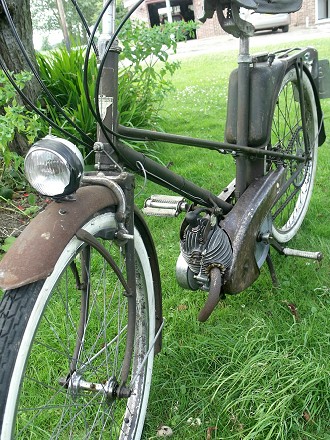
The magneto flywheel generator is fitted with a ‘black’ marker coil, which only develops a total output of 6V × 12W, which wasn’t really enough output to drive many electric horns of the time, so machines of this age were generally fitted with a bulb hooter, or an electric bell (Continent only, since this equipment wasn’t considered UK market legal at the time). The 6V × 6W headlamp produces a mellow glow though not anything you’d probably expect to see much by along a dark country road, it’s just there to mark your position to other road users in much the same manner as a period cycle lamp. The same rated 6V × 6W rear lamp creates a similar red spot in the night, to guard your back from approaching motorists.
The inverted brake levers prove fairly clumsy to operate, and are only as good as the condition of the front and rear blocks, and the maintenance of their controls. In this case the bike is fitted with new nylon-lined cables, so they’re about as good as they could probably be … but you could still wish they were better. There seems to be a fair bit of creaking and squeaking, but not so much stopping, and it’s easy to find occasions when you may be grateful the performance is so ‘unhurried’.
Riding around relatively deserted country lanes with a direct-drive machine is fairly relaxed, mostly judging the pace to keep the engine running if possible, with only an occasional stop on the decompresser required sometimes to pull up at a junction, then pedal off again and restart, but riding through a modern town centre could easily become more challenging.
We really like the unusual and distinctive straight-tube frame for its curious simplicity and economic design, but you may only see them infrequently.
In France the AV32 Utilitaire made its official appearance in October 1952, along with the AV33 Super-Standard as the AV3 disappeared from the catalogue. The AV32 Utilitaire presented the new third series Standard straight-tube frame while the other AV31 and AV33 models inherited the curved top tubes of the AV3. The October 1953 leaflet repeated the same three AV31, AV32, and AV33 models. The October 1954 leaflet again listed the AV31–33 models, but also presented a new AV37 Mobymatic Luxe with ‘3-speed’ variator. The AV37 has curved top-tubes but no seat stays, bringing on the fourth series De Luxe frame, and a larger 3.7 litre ‘bombe’ fuel tank.
So far the AV3–33 models were described as having a ‘cylindre aluminium chemisé’ (ie: sleeved cylinder) but when the AV37 appears, that is notably quoted as having a ‘cylindre aluminium chrome dur’ (ie: chrome plated cylinder), and representing introduction of the new AV35 engine.
A February 1955 leaflet seems to have been the last depicting the AV32 Utilitaire with its straight-tube frame, after which time the model reverted to a new curved top-tube Standard Model fourth series frame style, but without the rear stays.
So what happened to the straight tube frame?
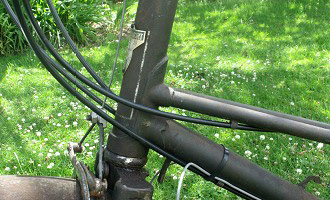
The two versions of the headstock joint.
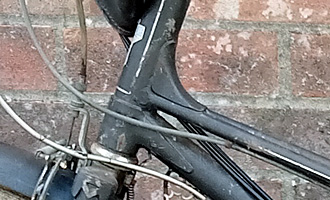
The story goes that unforgiving rigid forks transferred too much road shock to the straight-tube frame design with all the tube junctions at the bottom yoke, which proved insufficiently supported, and rather too prone to getting bent. The intoduction of extra strengthening pieces at the joint on later versions of this frame would support that story Retaining the straight tubes, but moving the junction up to the top of the steering stem to strengthen the frame would have compromised the ability to step through the frame and would have needed a new design of fuel tank, while the original curved top-tube design effectively supported the stem tube at the top, giving more structural strength, and the curved top tubes allowed an easier step-through capability, so Mobylette reverted to the established form.
One thing that did come out of the straight-tube Utilitaire frame exercise was that it did prove that the rear stays to the top of the saddle stem tube weren’t really necessary, so all subsequent versions of the Motobécane tubular frame omitted the rear stays.
In April 1952, a leaflet about the AV31 was sent to French
dealers with an accompanying letter dated 15 April 1952,
which advised of delays in delivery from Motobécane
because of shortages of materials:
Bicycles – 2 months
AV3 – 6 months
AV31 – 5 months
Motorcycles & scooters – 9 months
so an AV31 ordered in April presumably wouldn’t be expected
to appear until September!
Where an order had already been placed, however, up to 20% of the AV3s scheduled to be delivered in June, July, and August could be changed to AV31s instead—so the earliest an AV31 might have been delivered would be June 1952.
It seems unlikely that these problems were all resolved by October, so there would presumably have been some delays in the delivery of AV32 and AV33 models too? Dealers could still have been ordering the AV3 over the summer, so did Motobécane actually continue building curved-tube frame AV3s up to the end of 1952 to fulfil back orders, or did they just deliver straight-tube frame AV32s instead?
In the UK, the AV3 was imported from August 1951 and called ‘Mobylette Standard’ over here. In November 1952, Glass’s Index lists the new ‘Mobylette de Luxe’ and ‘Mobylette Super de Luxe’, which must have been the AV31 and AV33 models, while the Standard AV3 continued unchanged.
The De Luxe discontinued in September 1953, and in November 1953 the Standard was finally described as changing to a straight-tube frame (representing introduction of the AV32 Utilitaire, so presumably UK ‘Standards’ for most of 1953 had probably comprised of old AV3 clearance models, which had seemingly become obsolete at the factory in October 1952!
Also in November 1953, a new De Luxe was listed, though with the straight tube frame! But such a straight-tube framed model with auto-clutch and hub brake wouldn’t have matched any of the French market models, so there may have been an unusual derivation version just into the UK!
A French leaflet in February 1955 still illustrated four models, but also listed an AV32M described as being the same as the AV32 except for a hub brake in the rear wheel.
In June 1955 both Standard and De Luxe are listed in Glass’s as changing to a ‘Cradle Frame’, which must have meant the curved tube frame.
Parts lists in both French and English, only list a straight tube frame with fittings for a rear calliper brake and not a hub brake, which appear as the AV32U in the French list, and as Standard Model third Series in the English.
An October 1955 leaflet shows a new AV32S ‘Service’ replacing the AV32 Utilitaire. This has curved tubes, no seat stays and the small 0.55 gallon / 2½ litre tank. The engine is still advised as ‘cylindre aluminium chemisé’ (sleeved cylinder) and the illustration still shows the exhaust angled to the side.
All these dating anomalies just go to show how much Motobécane were introducing their new models straight into their home market, and clearing stock of the older models to export markets.
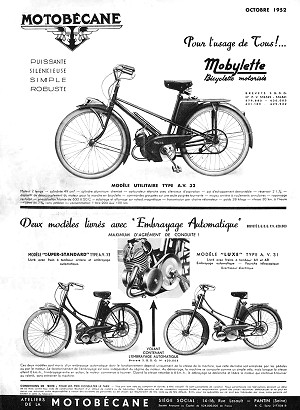
October 1952
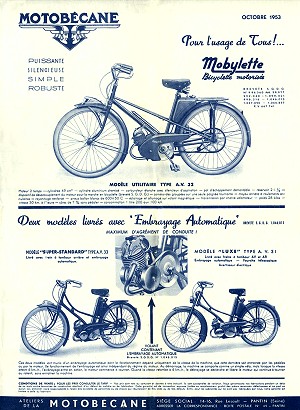
October 1953
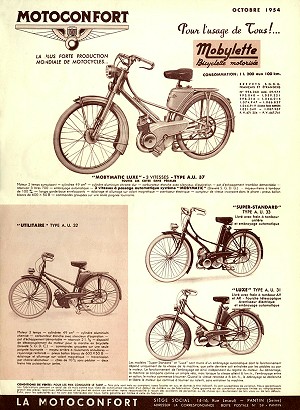
October 1954
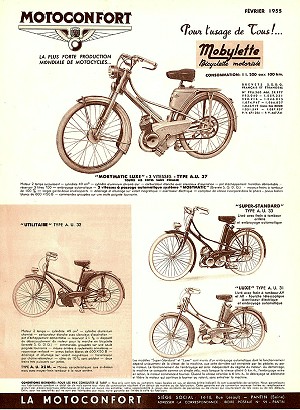
February 1955

October 1955


